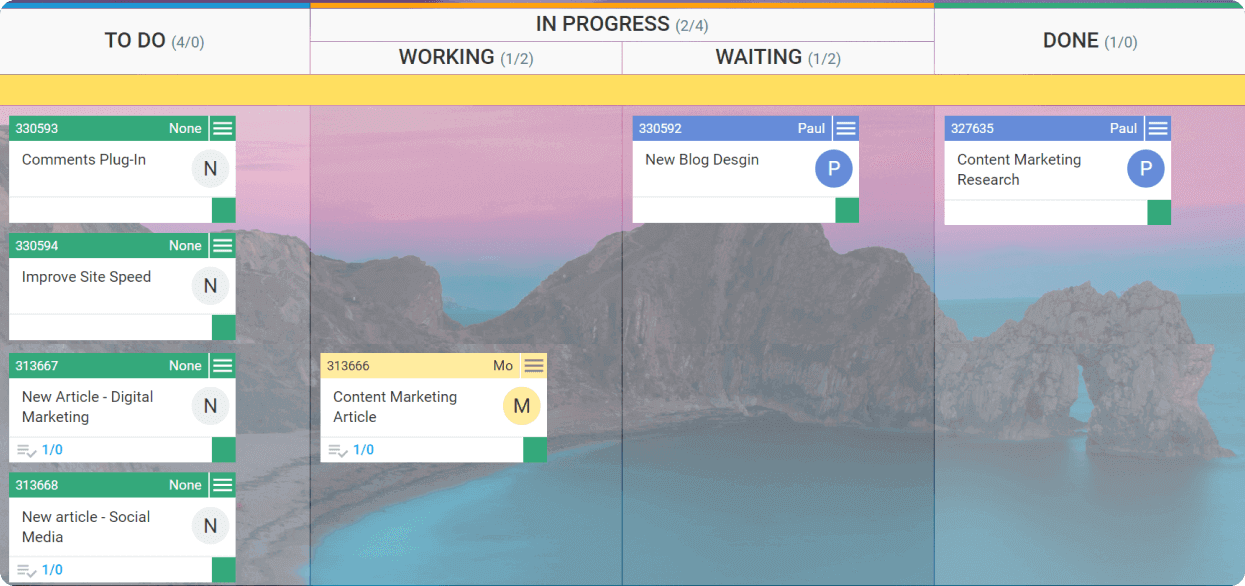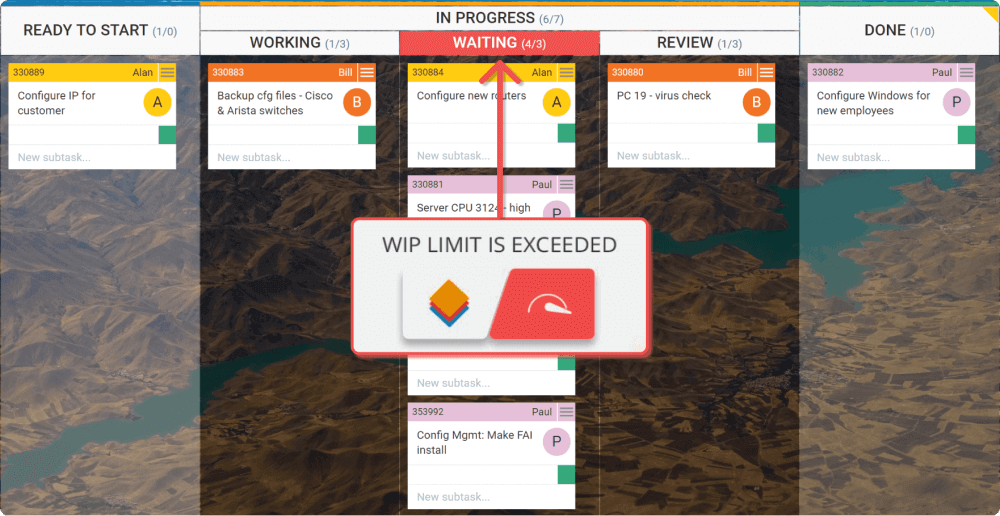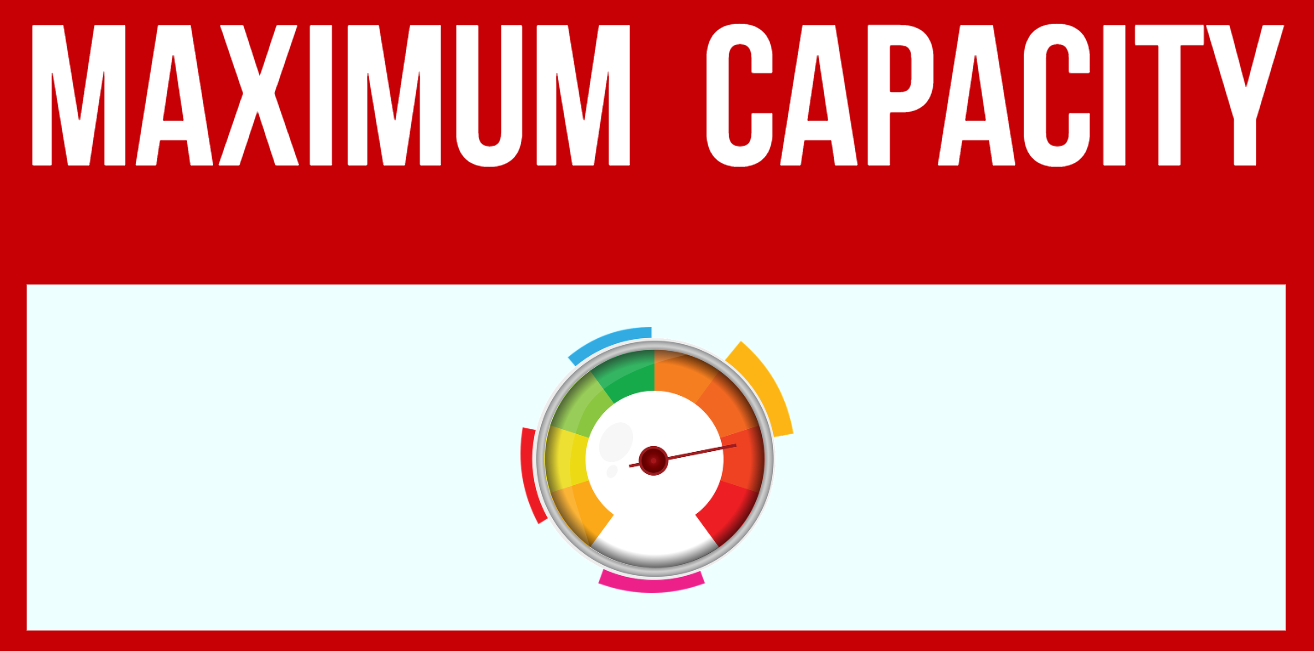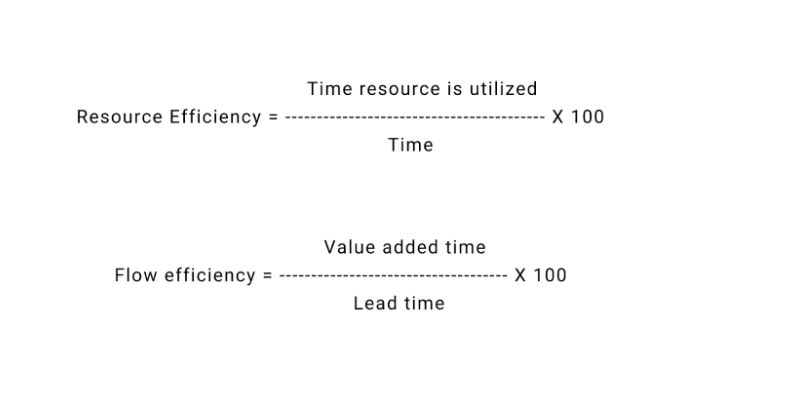When talking about product or service delivery, we're usually so focused on delivering within a certain time frame that we can forget how to do that efficiently. In our experience at Businessmap, we've frequently witnessed managers push their teams to start more work than they're able to finish.
This usually comes hand in hand with a messy work process, blocked tasks and team members, as well as an accumulation of stress when deadlines start knocking on the door.
This recurring event is largely due to the common management strategy of aiming to achieve maximum resource efficiency with little regard for flow efficiency. If you are not familiar with these two terms, you'll find the rest of the article valuable for optimizing the way you organize your work.
Explaining Resource Efficiency
Resource efficiency and flow efficiency are two sides of the same coin. Both are performance indicators related to how you manage your team and your process. Resource efficiency is how much of the capacity of your team you put to use. Following this line of thought, to achieve maximum resource efficiency, you need to keep yourself or your team (depending on the level of responsibility) busy 100% of the time.
At first thought, this seems like a pretty good idea for achieving vivid results and justifying your costs in terms of team members' salaries. In reality, keeping everyone busy all the time can prove to be counterproductive.
Nowadays, most knowledge work teams work on multiple projects simultaneously. Even the most simple initiatives, projects, features, epics, etc. require a team consisting of multiple stakeholders who are responsible for executing different parts of the work at hand.
When you are trying to keep all of them busy, the logical thing is to give new work to each person in advance, so they can start processing it as soon as they have available capacity. This would work perfectly if there was no chance for a work item to be returned for rework (which is almost never the case).
In reality, as soon as a team member is done working on an assignment, she will move on to the next task in the backlog until a manager reviews it. In the meantime, her colleague might have nothing to do with the initiative/project in progress yet, so he starts working on something completely different.
While there is ongoing work on another assignment, the manager might be done with the review and return the first task for rework. The responsible team member needs to leave everything at hand and fix the issue, or the assignment has to accumulate wait time. Eventually, a work item pops up for another member of the team who currently has no capacity due to a previous task that was already started.
Either way, everyone seems super busy, but the initiative or project is not progressing at optimal speed.
Flow Efficiency
Flow efficiency is the ratio between value-adding time and the lead time required to complete a process.
Optimizing your process for flow efficiency allows you to organize your overall capacity to deliver maximum value to your end customer in the shortest possible amount of time. It is almost a sacred metric for teams practicing Lean thinking.
When optimizing your process for flow efficiency, your goal is not to keep every person on your team constantly busy, but to keep all aspects of your work initiatives moving through your workflow. To achieve maximum flow efficiency, you need to have the capacity available all the time (slack). As a result, when one part of a work assignment is completed and it is ready to move to the next stage, a team member is ready to start working on it immediately.
On the other hand, if there is rework that needs to happen, the responsible team member is ready to start immediately because she hasn't rushed to begin new work immediately.
From a customer point of view, optimizing your process for flow efficiency is more important, as you will be able to deliver your product/service faster and very likely with better quality. You might ask why.
Because your team will be focused on a single project and their entire attention will be channeled towards the tasks that comprise it, leaving a minimum chance for mistakes caused by frequent context switching.
On the other hand, from an economic point of view, optimizing your team and your process entirely for flow efficiency might not seem like a wise idea, because your skilled and highly paid experts may turn out to be underutilized.
So how can you get the best from both approaches to managing capacity?
Flow Efficiency vs. Resource Efficiency: Combining the Two for Maximum Results
Like pretty much anything else in life, creating a balance can get you far when optimizing your process for both resource efficiency and flow efficiency. To begin with, you need to understand how to calculate both performance indicators. There are two very simple formulas for this purpose:
Resource Efficiency vs. Flow Efficiency formulas
When calculating resource efficiency, we take into consideration how much of the workweek each person spends actively doing their job. So, we divide the hours spent actively working (e.g. 30) by the 40 hours that comprise the standard workweek. Then, we multiply the result by 100 and learn that the person has been 75% efficient during the week we are analyzing.
When calculating flow efficiency, we focus on the time that it takes to process a work assignment after it has been requested by our customer.
Value added is the time when a team member is actively working, while lead time is the total time between request and completion. For example, if a customer request is completed in 90 days, but the value-added time is only 30 days, then by using the above-listed formula, it appears that the flow efficiency is 33%*.
*Although it seems like a low number, the median flow efficiency of a team very rarely goes above 20%.
Even if our team is fully utilized but the efficiency of our workflow is low, our efforts will be bringing the optimal value for neither us nor our clients. So, to optimize your work process for both resource efficiency and flow efficiency, there are 2 steps that you can take to maintain balance.
Visualize Your Workflow
Visualization is an invaluable weapon for managing a team. Especially in a dynamic environment such as knowledge work because when you visualize all assignments, it is less likely to accumulate humongous amounts of started but unfinished work.
There are hundreds of ways and tools available for work management, but if you have been working only with personal To-Do lists to this moment, I suggest you start with something simple like a Kanban board.
It is quite easy to use. You just dedicate any kind of a vertical flat surface (e.g. whiteboard, wall, window, etc.) for the purpose and draw a few horizontal lines for the different stages of your process.
 Visualizing work on a Kanban board can help you understand both your flow and resource efficiency
Visualizing work on a Kanban board can help you understand both your flow and resource efficiency
For example, you can start with a basic layout consisting of just 3 columns: To Do; In Progress; Done. Then, you put all tasks and their assignees on cards across the board depending on their state of completion. When the status is updated, you replicate it on the Kanban board.
It will be more than enough to make it transparent how many things each person on your team has in progress and how busy they really are.
Of course, the more detailed you draw your board, the more comprehensive visualization you will get. And still, keep in mind that you shouldn't overwhelm your board with too many work stages (columns) because they may turn out to be a waste. Here comes one of the benefits of having a digital Kanban board.
For example, with a board in Kanbanize, you will not only be able to map the entirety of your process but also analyze the value-added and non-value-added activities within it. This can help you determine whether certain stages are necessary or they add an additional overhead to your workflow.
Limit Work in Progress
Limiting your work in progress (WIP) will allow you to optimize your capacity and find the right balance between resource efficiency and flow efficiency. The logic is quite simple, really. You place a limit to the total amount of work items that can be in progress simultaneously and forbid starting new work until there are available slots for more tasks.

Utilizing WIP limits on a Kanban board to balance resource and flow efficiency
According to Little's Law, by reducing the amount of work in progress while maintaining your average completion rate of assignments, you will be able to reduce lead times and therefore, improve your flow efficiency.
Little's Law: Throughput = Work in Progress / Cycle time
In other words: Completed Tasks = Number of Tasks in Progress / The Time for Processing These Tasks
Depending on how strict limits you place, your process will become more optimized for either resource efficiency or flow efficiency.
For example, if you allow each team member to have just one task in progress, they won't be able to start new work until their current assignment is done and therefore, they might have plenty of unused capacity while waiting for review by other stakeholders or customers.
On the other hand, if you put very liberate WIP limits that allow team members to work on multiple tasks at once, they will surely be busy all the time, but the flow efficiency will suffer as a result.
So, the key to balancing both resource efficiency and flow efficiency is to find the sweet spot where the limit allows team members to have some flexibility to maneuver between tasks but little room for frequent context switching, so each person can utilize their capacity at high percent and yet not harm the overall flow efficiency of the campaigns at hand.
There isn't a golden rule for finding and maintaining a balance between the two performance metrics, but with the knowledge you gained by reaching the end of this article, you should have the necessary guidelines to find what works for your team best.
In conclusion, I'd like to provide you with one last piece of advice; When you begin experimenting with different WIP limits, start where you are and slowly tighten them. Monitor your performance metrics and adjust according to the results.
Good luck!

Alex Novkov
Content Lead
Energetic and practical, passionate about social media, creative writing, heavy weights, and outdoor activities.





